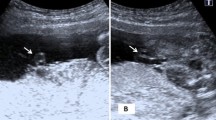Abstract
To compare perinatal outcomes of growth-restricted fetuses with bilateral positive end-diastolic (PED) flow at the perivesical segment (PVC) and growth-restricted fetuses with unilateral or bilateral absent/reverse end-diastolic (ARED) flow at the PVC segment. A total of 119 growth-restricted fetuses with PED flow at the free loop of the umbilical artery were enrolled in this cross-sectional study. Methods The patients were separated into three groups according to presence or absence of the end-diastolic flow at the perivesical segment. Patients with bilateral PED flow at the PVC segment were enrolled in Group1, patients with unilateral and bilateral (ARED) flow at the PVC segment were enrolled in Group 2 and 3, respectively. The perinatal outcomes of the groups were investigated. There were no significant differences between groups in terms of maternal age, gravida, parity, the gestational age at ultrasound examination and the pulsatility index of free umbilical artery. The gestational age at delivery, the birth weight and the interval between the diagnosis and delivery were found significantly higher in Group 1 than the other groups, there were no significant differences between Group 2 and 3 in terms of these parameters. More adverse pregnancy outcomes were observed in the unilateral and bilateral ARED flow groups than the bilateral PED flow group. In addition to the free loop Doppler indices, measuring the umbilical arteries Doppler indices at the PVC segment could contribute to the determination of more growth-restricted fetuses at risk of hypoxia.

Similar content being viewed by others
References
Alfirevic Z, Stampalija T, Dowswell T. Fetal and umbilical Doppler ultrasound in high-risk pregnancies. Cochrane Database Syst Rev. 2017;6:CD004529.
American College of Obstetricians and Gynecologists. Practice bulletin no. 145: antepartum fetal surveillance. Obstet Gynecol. 2014;124(1):182–92.
Society for Maternal-Fetal Medicine Publications Committee, Berkley E, Chauhan SP, Abuhamad A. Doppler assessment of the fetus with intrauterine growth restriction. Am J Obstet Gynecol. 2012;206(4):300–8.
American College of Obstetricians and Gynecologists. Practice bulletin no. 134: fetal growth restriction. Obstet Gynecol. 2013;121(5):1122–33.
Yarlagadda P, Willoughby L, Maulik D. Effect of fetal heart rate on umbilical arterial Doppler indices. J Ultrasound Med. 1989;8(4):215–8.
Maulik D, Yarlagadda AP, Youngblood JP, Willoughby L. Components of variability of umbilical arterial Doppler velocimetry—a prospective analysis. Am J Obstet Gynecol. 1989;160(6):1406–12.
Sonesson SE, Fouron JC, Drblik SP, Tawile C, Lessard M, Skoll A, et al. Reference values for Doppler velocimetric indices from the fetal and placental ends of the umbilical artery during normal pregnancy. J Clin Ultrasound. 1993;21(5):317–24.
Khare M, Paul S, Konje JC. Variation in Doppler indices along the length of the cord from the intraabdominal to the placental insertion. Acta Obstet Gynecol Scand. 2006;85(8):922–8.
Hadlock FP, Harrist RB, Sharman RS, Deter RL, Park SK. Estimation of fetal weight with the use of head, body, and femur measurements—a prospective study. Am J Obstet Gynecol. 1985;151(3):333–7.
Schaefer M, Wittstock G, Ville Y. Doppler ultrasound examination of fetal umbilical arteries of the intra-abdominal segment in normal singleton pregnancies. Z Geburtshlife Neonatol. 2000;204(4):135–9.
Friedman DM, Rutkowski M, Snyder JR, Lustig-Gillman I, Young BK. Doppler blood velocity waveforms in the umbilical artery as an indicator of fetal well-being. J Clin Ultrasound. 1985;13(3):161–5.
Figueras F, Fernandez S, Eixarch E, Gomez O, Martinez JM, Puerto B, et al. Umbilical artery pulsatility index: reliability at different sampling sites. J Perinat Med. 2006;34(5):409–13.
Lecarpentier E, Cordier AG, Proulx F, Fouron JC, Gitz L, Grange G, et al. Hemodynamic impact of absent or reverse end-diastolic flow in the two umbilical arteries in growth-restricted fetuses. PLoS ONE. 2013;8(11):e81160.
Vieyres P, Durand A, Patat F, Descamps P, Gregoire JM, Pourcelot D, et al. Influence of the measurement location on the resistance index in the umbilical arteries: a hemodynamic approach. J Ultrasound Med. 1991;10(12):671–5.
Vivanti AJ, Lecarpentier E, Cordier AG, Proulx F, Tsatsaris V, Benachi A. Relevance of routine Doppler sampling at the two umbilical arteries in the follow-up of dichorionic twin pregnancies with intrauterine growth-restricted fetuses. J Gynecol Obstet Hum Reprod. 2017;46(3):285–9.
Raio L, Ghezzi F, di Naro E, Franchi M, Balestreri D, Dürig P, et al. In-utero characterization of the blood flow in the Hyrtl anastomosis. Placenta. 2001;22(6):597–601.
Ullberg U, Sandstedt B, Lingman G. Hyrtl’s anastomosis, the only connection between the two umbilical arteries. A study in full term placentas from AGA infants with normal umbilical artery blood flow. Acta Obstet Gynecol Scand. 2001;80(1):1–6.
Predanic M, Kolli J, Yousefzadeh P, Pennisi J. Disparate blood flow patterns in parallel umbilical arteries. Obstet Gynecol. 1998;91(5 Pt 1):757–60.
Raio L, Ghezzi F, Di Naro E, Gomez R, Saile G, Brühwiler H. The clinical significance of antenatal detection of discordant umbilical arteries. Obstet Gynecol. 1998;91(1):86–91.
Janeczek S, Karlman R, MacMillan W. Left versus right intra-abdominal umbilical arteries: comparison of their Doppler waveforms. J Ultrasound Med. 2012;31(5):679–83.
Balbis S, Gaglioti P, Todros T, Guiot C. Doppler indices in the umbilical arteries: Influence of vessel curvature induced by bladder filling. Ultrasound Med Biol. 2007;33(12):1895–900.
Acknowledgement
The authors thank Arzu Baygül for her help with the manuscript and her valuable advice in the statistical analysis.
Author information
Authors and Affiliations
Corresponding author
Ethics declarations
Conflict of interest
The authors report no conflicts of interest.
Human and animal rights
All the procedures performed in studies involving human participants were in accordance with the ethical standards of the institutional and/or national research committee and with the 1964 Helsinki Declaration and its later amendments or comparable ethical standards.
Informed consent
Written informed consent was obtained from all patients prior to enrollment.
Additional information
Publisher's Note
Springer Nature remains neutral with regard to jurisdictional claims in published maps and institutional affiliations.
Rights and permissions
About this article
Cite this article
Kaya, B., Atiş Aydin, A. Umbilical Artery Doppler Indices at the Perivesical Segment in Growth-Restricted Fetuses. J. Fetal Med. 7, 213–218 (2020). https://doi.org/10.1007/s40556-020-00258-3
Received:
Accepted:
Published:
Issue Date:
DOI: https://doi.org/10.1007/s40556-020-00258-3




